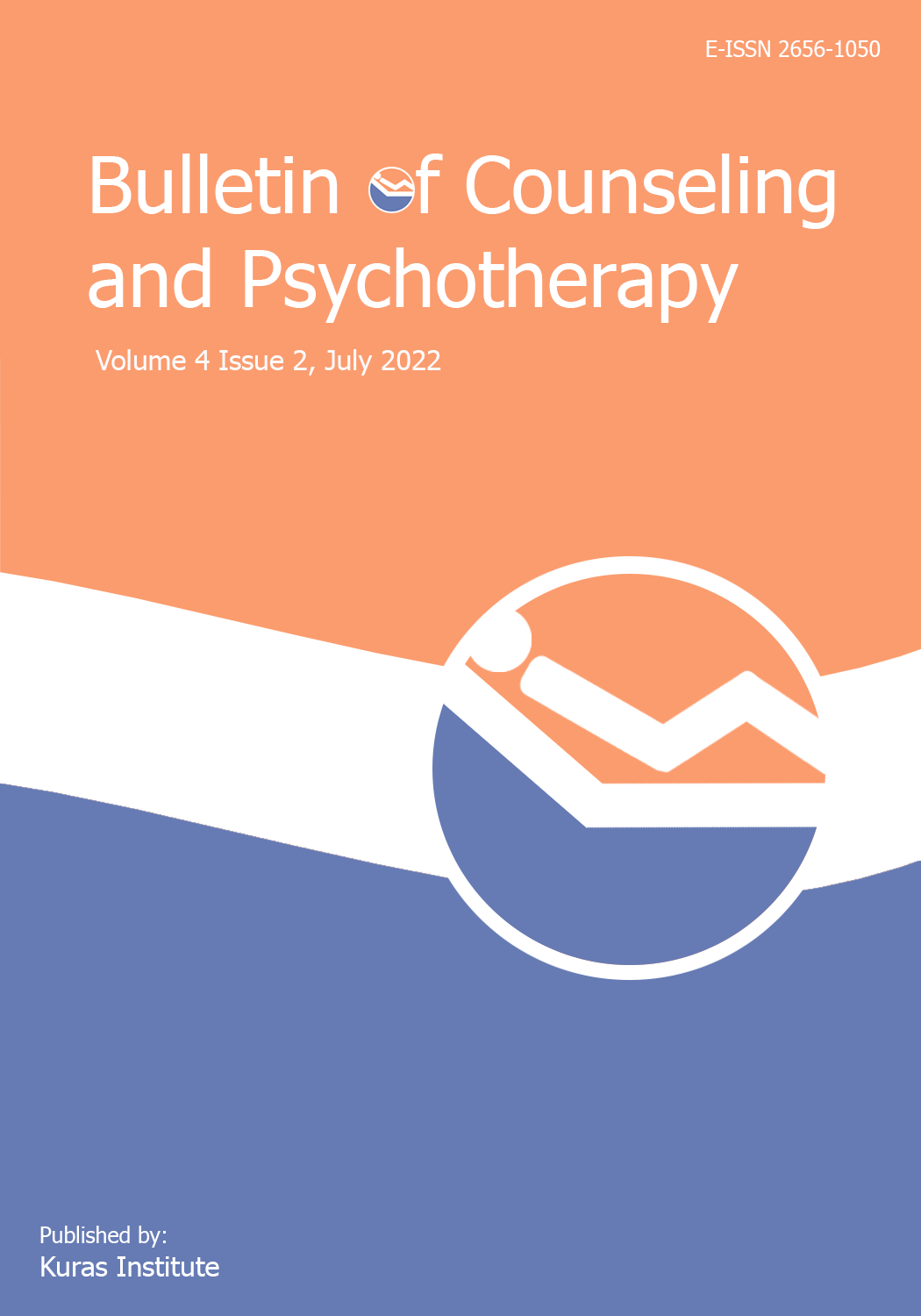Hubungan Dukungan Sosial Orangtua dengan Kecemasan Menghadapi Ujian Masuk Universitas pada Siswa Sekolah Menengah Atas Tingkat Akhir dalam Situasi Covid-19
Abstract
The purpose of this research is to determine the relationship between parental social support and anxiety in facing the University entrance exam test for the 12th grade students of Senior High School. The participants of this research are the 12th grade students of Senior High School who are about to take the University entrance exam test with a total of 122 participants. The sampling technique used in this research is quota sampling. The measurement instrument used is cognitive anxiety scale developed by Cassady & Johnson to measure anxiety and parental social support scale created by Gunandar referring to Sarafino's theory to measure parental social support. This research was conducted online with questionnaires distributed via Google Form to the 12th grade students of Senior High School. The correlation test uses Pearson correlation technique with the help of IBM SPSS program for Windows version 20. The result generated from this research shows that the correlation coefficient (r) = -0.300 with the value of sig 0.000 (p<0.05). This means that there is a negative relationship between anxiety and parental social support for the 12th grade students of Senior High School. This also could mean the higher the parental social support obtained, the lower the anxiety become, and vice versa.
Downloads
References
Afifa, N. S. (2020). Dukungan sosial dengan tingkat kecemasan siswa dalam menghadapi ujian akhir nasional. Jurnal Ilmiah Kesehatan Sandi Husada, 11(1), 78-85. https://doi.org/10.35816/jiskh.v11i1.221
Albertus, A. (2020, Juni 28). LTMPT: Ini protokol lengkap A sampai H pelaksanaan UTBK 2020 Terbaru. Diakses pada oktober 17, 2021. Kompas. Google
Anhusadar, L. (2020). Persepsi mahasiswa PIAUD terhadap kuliah online di masa pandemi COVID 19. Kindergarten: Journal of Islamic Early Childhood Education, 3(1), 44-58. http://dx.doi.org/10.24014/kjiece.v3i1.9609
Asrifa, N. D. (2021). Hubungan dukungan orang tua dengan kecemasan pada mahasiswa Fakultas Keguruan dan Ilmu Pendidikan Universitas Sultan Ageng Tirtayasa angkatan 2017 yang sedang menyusun skripsi. Jurnal al-Shifa Bimbingan Konseling Islam, 2(1), 39-51. http://dx.doi.org/10.32678/alshifa.v2i1.4696
Azwar, S. (2012). Reliabilitas dan validitas. Yogyakarta: pustaka pelajar. Google Scholar
Cassady, J. C., & Johnson, R. E. (2002). Cognitive test anxiety and academic performance. Contemporary educational psychology, 27(2), 270-295. https://doi.org/10.1006/ceps.2001.1094
CNN Indonesia (2020, Juli 06). Cemas peserta sbmptn saat ujian di tengah pandemi corona. cnnindonesia.com
Danu Damarjati (2020, Juni 24). COVID-19 masih mewabah, UTBK-SBMPTN akan dilaksanakan 2 gelombang. detik. Google
Kementrian Kesehatan Republik Indonesia. (2020). Pedoman pencegahan dan pengendalian Coronavirus Disease 2019 (Covid-19). infeksiemerging.kemkes. Google
Kementerian Pendidikan dan Kebudayaan Republik Indonesia. (2020). Penerimaan mahasiswa baru program sarjana pada perguruan tinggi negeri. kemendikbud. Google
Lastina, F. F., & Abidin, Z. (2013). Hubungan antara dukungan sosial dengan kecemasan menghadapi ujian nasional pada siswa SMA Negeri 2 Kota Magelang. Jurnal empati, 2(3), 359-368. https://doi.org/10.14710/empati.2013.7360
Macdonald, G. (1998). Development of a social support scale: An evaluation of psychometric properties. Research on Social Work Practice, 8(5), 564-576. https://doi.org/10.1177/104973159800800505
Mahar Prastiwi (2021, April 10). Calon mahasiswa, simak jawaban LTMPT seputar persiapan UTBK-SBMPTN. kompas. Google
Maharani, T. I., & Fakhrurrozi, M. (2014). Hubungan dukungan sosial dan kecemasan dalam menghadapi persalinan pada ibu hamil trimester ketiga. Jurnal Psikologi, 7(2). Google Scholar
Maramis, F. W. (2009). Catatan ilmu kedokteran jiwa (2nd ed). Surabaya: Airlangga University Press. Google Scholar
Mona, N. (2020). Konsep isolasi dalam jaringan sosial untuk meminimalisasi efek contagious (kasus penyebaran virus corona di Indonesia). Jurnal Sosial Humaniora Terapan, 2(2). https://doi.org/10.7454/jsht.v2i2.86
Nevid, S. J., Rathus, A. S., dan Greene, B. (2005). Psikologi Abnormal (5th ed). Jakarta: Penerbit Erlangga. Google Scholar
Putri, H. M., & Febriyanti, D. A. (2020). Hubungan dukungan sosial orangtua dengan kecemasan menghadapi dunia kerja pada mahasiswa tingkat akhir fakultas Psikologi Universitas Diponegoro. Jurnal Empati, 9(5), 375-383. https://doi.org/10.14710/empati.2020.29261
Rambe, Y. S. (2017). Hubungan self efficacy dan dukungan sosial dengan kecemasan siswa menghadapi Ujian Nasional Berbasis Komputer (UNBK) di SMK swasta PAB 12 Saentis. Analitika: Jurnal Magister Psikologi UMA, 9(1), 60-67. https://doi.org/10.31289/analitika.v9i1.740
Sarafino, E. P., & Smith, T. W. (2012). Health psychology: Biopsychosocial interactions (7th ed). John Wiley & Sons. Google Scholar
Sekarina, D. P., & Indriana, Y. (2018). Hubungan antara dukungan sosial orangtua dengan kecemasan menghadapi dunia kerja pada siswa kelas XII SMK Yudya Karya Magelang. Empati, 7(1), 381-386. https://doi.org/10.14710/empati.2018.20254
SSC Sidoarjo (2020, April 14). 5 hal yang pasti dirasakan siswa kelas XII SMA saat semester akhir. sidoarjo.bimbelssc. Google
Sugiyono, prof. dr. (2013). Metode penelitian pendidikan pendekatan kuantitatif, kualitatif, dan R&D. Bandung: Alfabeta. Google Scholar
Undang-undang Republik Indonesia. (1989). Sistem pendidikan nasional. Google
Wade, C & Travis, C. (2007). Psikologi. (9th ed). Jilid 2. (terjemahan: Padang Mursalin dan Dinastuti). Jakarta: Erlangga. Google Scholar
Copyright (c) 2022 Anastasia Putri, Maria Nugraheni M. Rahayu

This work is licensed under a Creative Commons Attribution 4.0 International License.
Authors who publish with this journal agree to the following terms:
1) Authors retain copyright and grant the journal the right to first publication, with the work simultaneously licensed under the Creative Commons Attribution that allows the sharing of articles published with the acknowledgement of authorship and the initial publication in this magazine.
2) The authors are authorized to make additional contracts separately for distribution of the version of the work published in this journal (for example, publication in an institutional repository or as a chapter of the book), as long as there is recognition of authorship and initial publication in this journal.
3) Authors are authorized and encouraged to publish and distribute their work online (for example, in institutional repositories or on their personal pages) at any time before or during the editorial process, as it increases the impact and reference of the published work.







